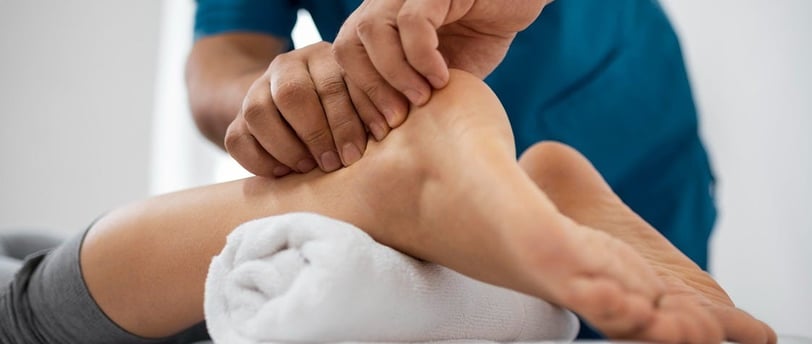The Art of Reflexology: Mapping Your Body's Healing Potential
Imagine a map of your entire body, intricately drawn onto the soles of your feet, the palms of your hands, and even your ears. This isn't just a fascinating concept; it's the foundational principle of reflexology, an ancient healing art that suggests these "reflex points" correspond to organs, glands, and systems throughout your body.
7/11/20253 min read


Imagine a map of your entire body, intricately drawn onto the soles of your feet, the palms of your hands, and even your ears. This isn't just a fascinating concept; it's the foundational principle of reflexology, an ancient healing art that suggests these "reflex points" correspond to organs, glands, and systems throughout your body.
In a world where we often feel disconnected from our own physical needs, reflexology offers a unique pathway to understanding and supporting our internal well-being. It's a non-invasive, complementary therapy that seeks to unlock the body's natural healing capabilities and restore balance.
The Ancient Roots and Modern Understanding of Reflexology
The practice of reflexology boasts ancient roots and a modern understanding. Evidence of foot and hand therapy dates back thousands of years, with depictions found in ancient Egyptian tombs and mentions in traditional Chinese and Indian medicine. While its precise origins remain debated, the core idea of applying pressure to specific points to influence distant body parts has been a persistent thread in global healing traditions.
Modern reflexology, as we know it today, was significantly developed in the early 20th century by Dr. William Fitzgerald, who introduced "Zone Therapy," and later refined by Eunice Ingham, a physiotherapist who meticulously mapped the reflex points on the feet and hands.
Today, scientific theories, though still developing, often point to the nervous system, energy pathways (Qi or Lom), and improved circulation as potential mechanisms for its beneficial effects, highlighting its evolution from ancient wisdom to a recognized complementary therapy.
Decoding Your Body's Map: Reflex Points Explained
At the core of reflexology is decoding your body's map: reflex points explained. Reflexologists work with detailed charts that illustrate the intricate connections between specific areas on the feet, hands, and ears, and various organs, glands, and body parts.
For example, the tips of your toes might correspond to your head and brain, while the ball of your foot is often linked to your lungs and heart. The heel can relate to the lower back and sciatic nerve.
By applying targeted pressure to these reflex points, a practitioner aims to stimulate nerve endings, improve blood flow, and clear energy blockages in the corresponding body area. This systematic approach allows reflexology to address issues throughout the body, even though the primary focus of the treatment might be on the feet.
The Therapeutic Benefits: More Than Just Relaxation
While profoundly relaxing, the therapeutic benefits: more than just relaxation are what truly define reflexology. It is widely recognized for its ability to reduce stress and anxiety by calming the nervous system, shifting the body from a "fight or flight" response to a state of deep rest and healing.
Beyond relaxation, many report improved circulation, which aids in oxygen and nutrient delivery to cells and facilitates the removal of toxins. Reflexology is also sought after for pain relief, as it can encourage the body's natural release of endorphins.
Additionally, practitioners and clients often report benefits such as improved sleep, enhanced immune function, better digestion, and even hormonal balance, making it a valuable tool for holistic well-being.
The Reflexology Session: What to Expect
A typical reflexology session: what to expect is a comfortable and gentle experience. You will usually remain fully clothed, removing only your shoes and socks if the feet are the focus. You'll typically recline in a comfortable chair or lie on a massage table.
The reflexologist will begin by assessing your feet or hands and then use various techniques, primarily thumb and finger pressure, to work systematically across the reflex points. They might use a lotion or cream, though it's not always necessary.
The pressure applied can vary from light to firm, depending on your comfort and the therapist's assessment. While you may feel tenderness in certain areas corresponding to imbalances in the body, the overall experience should be soothing and restorative.
Conclusion
Your Body's Blueprint: Navigating Health Through Reflexology underscores the profound potential of this ancient yet ever-relevant healing art. By understanding the intricate connections between specific points on your extremities and your body's internal systems, reflexology offers a powerful, non-invasive pathway to improved health and well-being.
Whether you seek stress relief, pain management, enhanced circulation, or simply a deeper connection to your body's innate healing capabilities, exploring reflexology can be a truly transformative experience. Visit wiki-reflexology.com to delve further into this fascinating practice and take the first step in discovering your body's unique blueprint for health.
Reflexology
Therapeutic practice applying pressure specific points hands ears.
Holistic Therapy
Foot Massage
Foot Reflexology
Reflexology massage
Pain relief therapy
Pressure points
© 2024. All rights reserved. Designed by Pimclick - SEO Agency
